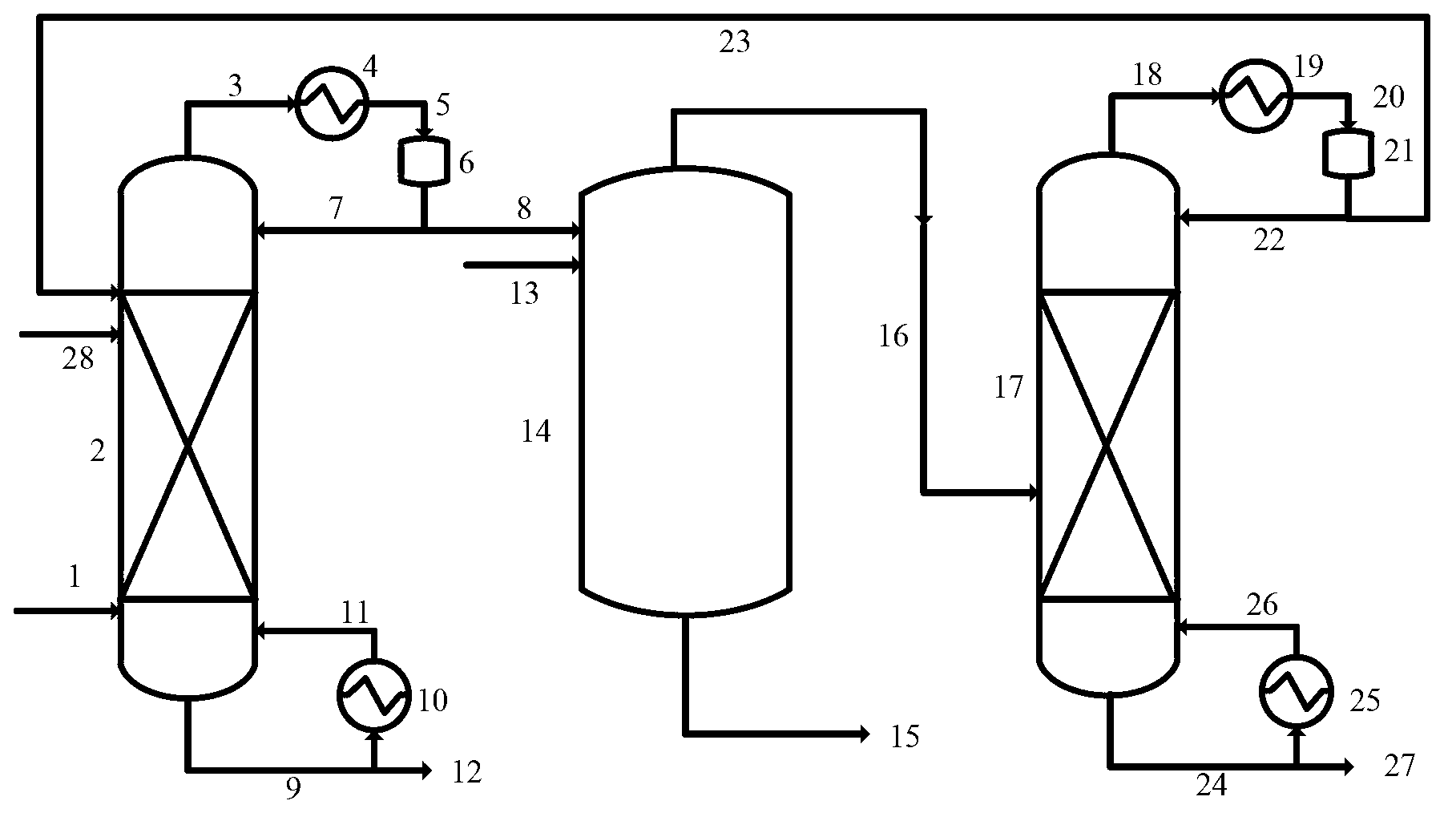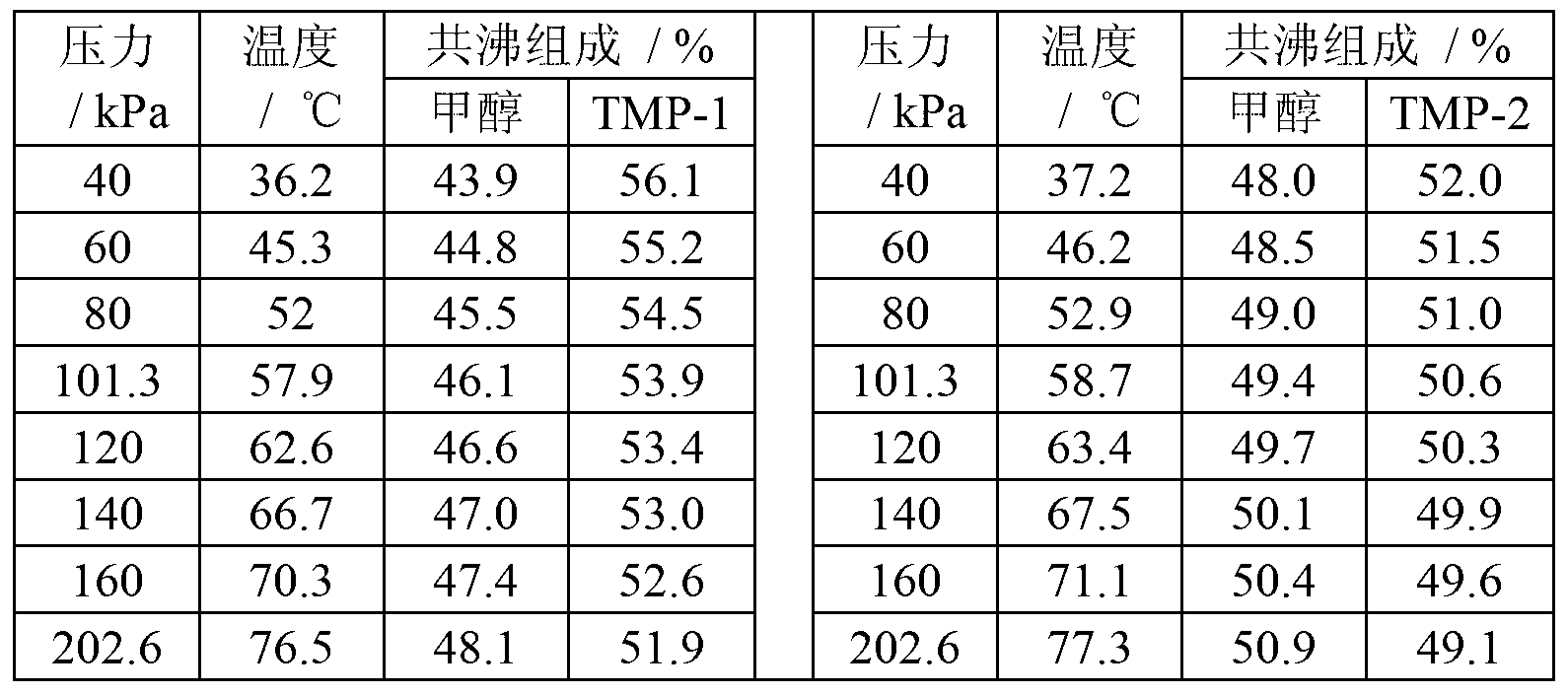Method for separating mixture of diisobutylene and tertiary butanol
A technology of diisobutene and tert-butanol, applied in chemical instruments and methods, preparation of organic compounds, distillation purification/separation, etc., can solve problems such as azeotropic separation, which is not seen, and achieve the effect of simple operation and good separation effect.
- Summary
- Abstract
- Description
- Claims
- Application Information
AI Technical Summary
Problems solved by technology
Method used
Image
Examples
Embodiment 1
[0037] The quality of raw material liquid is 1500kg, the mass fractions of diisobutene and tert-butanol are 44.8% and 55.2% respectively, wherein TMP-1:TMP-2=76:24, add methanol 594.3kg therein, carry out intermittently under operating pressure 101.3kPa Rectification, reflux ratio 5. The temperature at the top of the tower is 59.0°C, the mass fractions of diisobutene and methanol at the top of the tower are 53.1% and 46.9%, respectively, and the mass is 1265.4kg. The mass fraction of tert-butanol in the tower kettle is 99.9%, and the mass is 828.8kg.
[0038] 379.6 kg of extractant water was added to the overhead distillate, and intermittent extraction was adopted. The extraction residence time was 0.5 h. The mass fraction of diisobutene in the extracted oil phase was 99.8%, and the mass of the oil phase was 673.3 kg. The water phase methanol solution is 971.7kg, and the methanol solution is rectified at atmospheric pressure with a reflux ratio of 4, and methanol with a mass ...
Embodiment 2
[0040] The mass fractions of diisobutylene and tert-butanol in the feed liquid are 30.0% and 70.0% respectively, wherein TMP-1:TMP-2=80:20 is continuously fed to the rectification tower at a mass flow rate of 1500.0kg / h; Flow rate 429.7kg / h continuously feeds methanol into the rectification tower. The operating pressure is 202.6kPa, and the reflux ratio is 8. The temperature at the top of the tower was 77.1°C. The mass fractions of diisobutene and methanol obtained at the top of the tower are 51.2% and 48.8%, respectively, and the distillation rate is 879.2kg / h; the mass fraction of tert-butanol in the tower bottom is 99.6%, and the recovery rate is 1050.5kg / h.
[0041] Add extractant water with the flow rate of 1758.4kg / h, in the extraction tower, continuously contact with the overhead distillate from the rectification tower to extract, the residence time is 0.1h, and obtain the oil phase with the flow rate of 452.3kg / h, wherein two The mass fraction of isobutene was 99.5%,...
Embodiment 3
[0043] Diisobutylene and tert-butanol mass fractions are respectively 25% and 75% in the raw material liquid, wherein TMP-1:TMP-2=50:50, feed continuously in the rectification tower with mass flow rate 1500.0kg / h; Simultaneously Methanol is continuously fed into the rectification tower at a mass flow rate of 328.8kg / h. The operating pressure is 60kPa, and the reflux ratio is 2. The azeotropic temperature at the top of the tower is 45.8°C, the mass fractions of diisobutene and methanol obtained at the top of the tower are 46.7% and 53.3%, respectively, and the distillation rate is 703.8kg / h. The mass fraction of tert-butanol in the tower kettle is 99.5%, and the recovery rate is 1125kg / h.
[0044] Add extractant water at a flow rate of 1055.7kg / h, and continuously contact with the overhead distillate from the rectification tower in the extraction tower for extraction. The residence time is 5h, and the oil phase is obtained at a flow rate of 376.9kg / h, wherein diisobutene The ...
PUM
 Login to View More
Login to View More Abstract
Description
Claims
Application Information
 Login to View More
Login to View More - R&D
- Intellectual Property
- Life Sciences
- Materials
- Tech Scout
- Unparalleled Data Quality
- Higher Quality Content
- 60% Fewer Hallucinations
Browse by: Latest US Patents, China's latest patents, Technical Efficacy Thesaurus, Application Domain, Technology Topic, Popular Technical Reports.
© 2025 PatSnap. All rights reserved.Legal|Privacy policy|Modern Slavery Act Transparency Statement|Sitemap|About US| Contact US: help@patsnap.com



